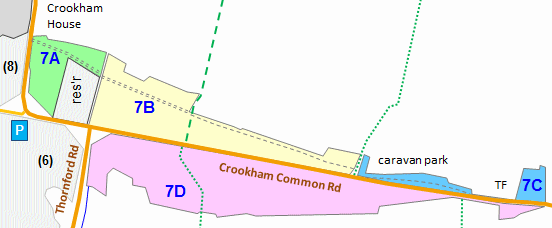
Compartment 7 occupies 23.7 ha at the extreme eastern end of the common. It straddles Crookham Common Road, which separates subcompartments 7A, 7B and 7C on the north side from 7D on the south.
There are access tracks to a number of properties, and connections with four public rights of way. A well established path traverses the subcompartments on the north side of the road, travelling west-east from Crookham Hill Road to the caravan park entrance, then south of the caravan park almost as far as the Travellers Friend.
The compartment is not part of the stock-fenced and grazed area of the main common, being separated from it by Crookham Hill Road, Old Thornford Road and compartment 6.
The southern edge of subcompartment 7D enjoys some extensive views over the Enborne valley towards the Downs.
General description and evaluation of ecology
Compartment 7 is predominantly secondary woodland with small patches of scrub and acid grassland. Some more mature oaks are present in the wooded areas. There is potential to open up glades to create a more diverse mosaic of habitats. Shallow scrapes are evident in 7B and 7D, and could be enhanced for the use of invertebrates. Some of the scrapes in 7D are part of a series of ephemeral ponds and should be included in the ponds management plan. There are some stands of ageing gorse on the eastern end of subcompartment 7D. Clearance along cable lines has created woodland rides that criss-cross the compartment. An old lime tree avenue is evident in 7A that was probably the approach to Crookham House. The whole of compartment 7 is SSSI.
BAP habitats
None.
Higher Level Stewardship
No HLS agreement currently exists for this compartment. However a Farm Environment Plan was submitted to Natural England in 2008 so that at a future date it may be possible for this area to be incorporated into HLS or a successor scheme.
Overall management objectives
Expand woodland rides and create glades along existing cable lines to diversify habitat. Protect any mature trees by creating 'halos' around them. Clear south facing banks to enhance the habitat for invertebrates. Ensure a suitable cutting regime is in place to maintain existing grassland and prevent encroachment of scrub that currently borders these areas. Manage public rights of way and other paths that cross the compartment, particularly as some could suffer from encroachment of scrub.
Subcompartment 7A (2.4 ha)
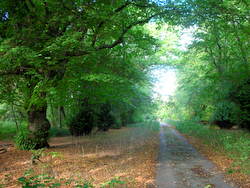
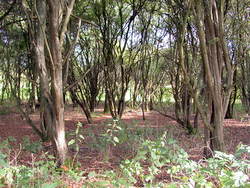
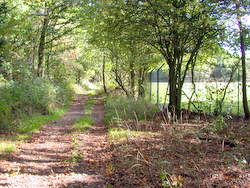
A small area to the north of Crookham Common Road containing mixed secondary woodland and plantation oak around a covered reservoir (not owned by WBC and not part of the common). There are some old open-grown oaks, yew, holly, birch, and an area of tall hawthorns with minimal ground flora (mainly stinging nettles) beneath. A lime tree avenue borders an access track to Crookham House, part of the historic approach to the manor.
| Objective | Area | Method | Comments |
|---|---|---|---|
| 7A.1) Manage as minimum intervention. | Wooded area to the north of Crookham Common Road and west of the reservoir. | Thin surrounding smaller trees to protect the full crown of the open-grown oaks. Coppice tall hawthorns, remove sycamore saplings. | |
| 7A.2) Restore lime tree avenue. | Both sides of access track to Crookham House. | Remove encroaching nettle and small trees, investigate desirability of removing lower branches from limes. | Liaise with Tree Officer. Consider ring-barking the large sycamore immediately east of the avenue. |
Subcompartment 7B (7.4 ha)
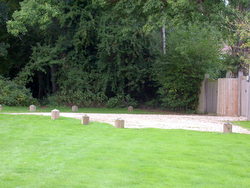
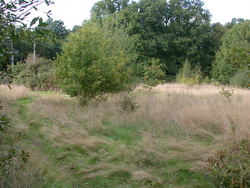
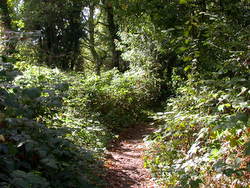
This area, to the north of Crookham Common Road and to the east of subcompartment 7A, comprises oak woodland with other trees and shrubs including birch, yew, willow, hawthorn, holly, and crab apple. There are small areas of scrub and acid grassland bordering two minor tracks to properties. A well established path passes through the subcompartment, travelling west-east and connecting two public rights of way while avoiding road walking.
| Objective | Area | Method | Comments |
|---|---|---|---|
| 7B.1) Diversify the woodland structure on a small scale. | Whole of 7B | Create small glades by felling secondary woodland areas and scalloping woodland edges and widening glades, trackways and paths.
Halo around mature oaks to allow full crowns to develop. Maintain structural diversity in area of blackthorn. Selectively remove scrub to encourage age variation and maintain diversity of habitat. |
Rides are important to connect different habitats across this area. Focus on maintaining existing open areas and electricity wayleave clearances. |
| 7B.2) Protect and manage grassland areas. | Cable rides and bordering access tracks to properties. | Introduce a mowing regime to maintain areas of acid grassland and expand them into the surrounding scrub. | Liaise with local residents to ensure continued mowing of some areas outside properties. |
Subcompartment 7C (1.3 ha)
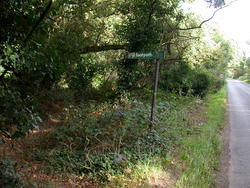
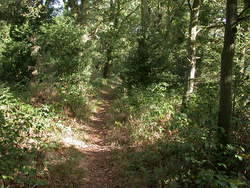

Two separate small areas make up 7C. The first is a mature oak woodland to the north of Crookham Common Road, bordering the caravan park. The second area, further east, is a small block of grassland scrub and a small wooded area bordering the track to properties just north of the road. A well used path, a continuation of that in 7B, travels west-east through the woodland between the caravan park and the road.
| Objective | Area | Method | Comments |
|---|---|---|---|
| 7C.1) Maintain recreational route footpath. | Footpath running east-west, just south of the caravan park. | Maintain trees alongside footpath in a safe condition. Check scrub encroachment. | |
| 7C.2) Manage grassland. | Far eastern block alongside track leading to property off Crookham Common Road. | Remove bramble to stop encroachment by scrub. Liaise with residents to ensure suitable cutting regime is maintained. | Speak to residents regarding mowing grassland on an annual basis. |
Subcompartment 7D (12.6 ha)
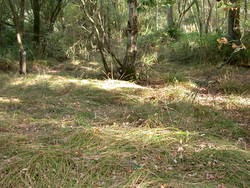
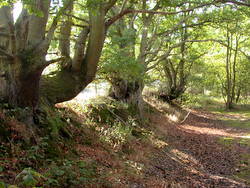
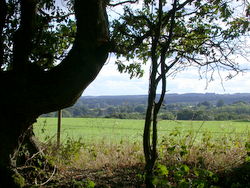
This area lies south of Crookham Common Road and consists mainly of secondary woodland dominated by birch and oak. Coppiced oak is frequent and the boundary bank to the south of the compartment supports some impressive oaks, with growth habits suggesting outgrown hedge trees. There are also patches of oak, birch, gorse, and bramble scrub. Fragments of acid grassland and small clearings are present, particularly along existing cable lines and track edges. Some ephemeral ponds are situated close to the southern boundary. Some minor gravel extraction pits remain throughout the compartment.
| Objective | Area | Method | Comments |
|---|---|---|---|
| 7D.1) Diversify woodland structure and connect open areas and ponds with a network of rides. | Whole of 7D. | Create woodland glades along cable lines and access tracks, favouring current areas of acid grassland. Scallop into rides edges each year and allow to regrow. Thin areas on southern edge of 7D to open up views.
Open up the old gravel pits by selectively felling birch and gorse, to allow better light penetration onto the south facing banks. Focus glade clearance of woodland around these areas. Open up canopy around ponds and damp areas, and incorporate ponds into ponds management plan. Some ponds could be extended by some minor excavation. |
Consider links to southern fields and views southwards to the Downs.
Wayleave connection along electricity cables a major factor here. Consider extending footpath towards eastern end of subcompartment. |
| 7D.2) Manage and enhance grassland. | Far eastern block, opposite the Travellers Friend public house. | Check encroachment of bramble and incorporate into a suitable mowing plan. Maintain scrub screen against road to discourage parking. |